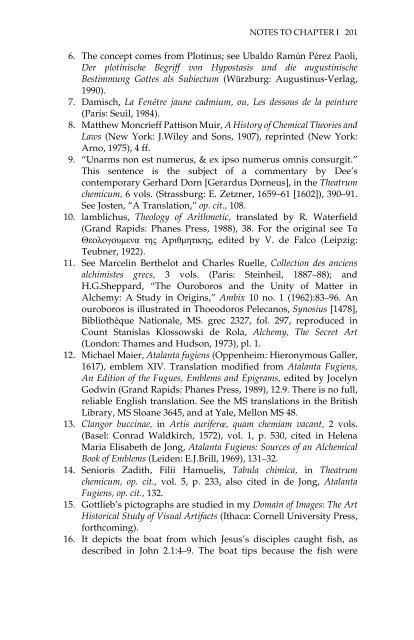What Painting Is: How to Think about Oil Painting ... - Victoria Vesna
What Painting Is: How to Think about Oil Painting ... - Victoria Vesna
What Painting Is: How to Think about Oil Painting ... - Victoria Vesna
You also want an ePaper? Increase the reach of your titles
YUMPU automatically turns print PDFs into web optimized ePapers that Google loves.
NOTES TO CHAPTER I 201<br />
6. The concept comes from Plotinus; see Ubaldo Ramún Pérez Paoli,<br />
Der plotinische Begriff von Hypostasis und die augustinische<br />
Bestimmung Gottes als Subiectum (Würzburg: Augustinus-Verlag,<br />
1990).<br />
7. Damisch, La Fenêtre jaune cadmium, ou, Les dessous de la peinture<br />
(Paris: Seuil, 1984).<br />
8. Matthew Moncrieff Pattison Muir, A His<strong>to</strong>ry of Chemical Theories and<br />
Laws (New York: J.Wiley and Sons, 1907), reprinted (New York:<br />
Arno, 1975), 4 ff.<br />
9. “Unarms non est numerus, & ex ipso numerus omnis consurgit.”<br />
This sentence is the subject of a commentary by Dee’s<br />
contemporary Gerhard Dorn [Gerardus Dorneus], in the Theatrum<br />
chemicum, 6 vols. (Strassburg: E. Zetzner, 1659–61 [1602]), 390–91.<br />
See Josten, “A Translation,” op. cit., 108.<br />
10. lamblichus, Theology of Arithmetic, translated by R. Waterfield<br />
(Grand Rapids: Phanes Press, 1988), 38. For the original see Tα<br />
Θεoλoγoυµενα της Apιθµητικης, edited by V. de Falco (Leipzig:<br />
Teubner, 1922).<br />
11. See Marcelin Berthelot and Charles Ruelle, Collection des anciens<br />
alchimistes grecs, 3 vols. (Paris: Steinheil, 1887–88); and<br />
H.G.Sheppard, “The Ouroboros and the Unity of Matter in<br />
Alchemy: A Study in Origins,” Ambix 10 no. 1 (1962):83–96. An<br />
ouroboros is illustrated in Thoeodoros Pelecanos, Synosius [1478],<br />
Bibliothèque Nationale, MS. grec 2327, fol. 297, reproduced in<br />
Count Stanislas Klossowski de Rola, Alchemy, The Secret Art<br />
(London: Thames and Hudson, 1973), pl. 1.<br />
12. Michael Maier, Atalanta fugiens (Oppenheim: Hieronymous Galler,<br />
1617), emblem XIV. Translation modified from Atalanta Fugiens,<br />
An Edition of the Fugues, Emblems and Epigrams, edited by Jocelyn<br />
Godwin (Grand Rapids: Phanes Press, 1989), 12.9. There is no full,<br />
reliable English translation. See the MS translations in the British<br />
Library, MS Sloane 3645, and at Yale, Mellon MS 48.<br />
13. Clangor buccinae, in Artis auriferœ, quam chemiam vacant, 2 vols.<br />
(Basel: Conrad Waldkirch, 1572), vol. 1, p. 530, cited in Helena<br />
Maria Elisabeth de Jong, Atalanta Fugiens: Sources of an Alchemical<br />
Book of Emblems (Leiden: E.J.Brill, 1969), 131–32.<br />
14. Senioris Zadith, Filii Hamuelis, Tabula chimica, in Theatrum<br />
chemicum, op. cit., vol. 5, p. 233, also cited in de Jong, Atalanta<br />
Fugiens, op. cit., 132.<br />
15. Gottlieb’s pic<strong>to</strong>graphs are studied in my Domain of Images: The Art<br />
His<strong>to</strong>rical Study of Visual Artifacts (Ithaca: Cornell University Press,<br />
forthcoming).<br />
16. It depicts the boat from which Jesus’s disciples caught fish, as<br />
described in John 2.1:4–9. The boat tips because the fish were


